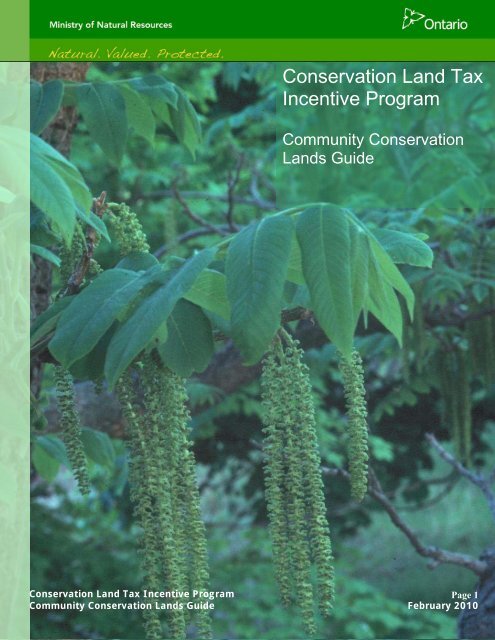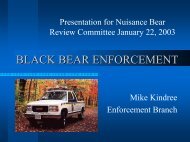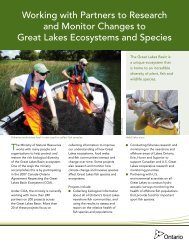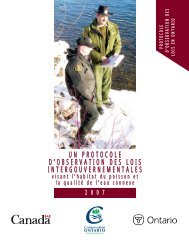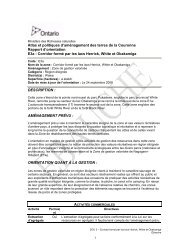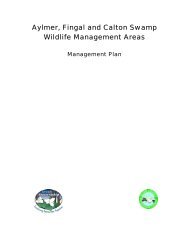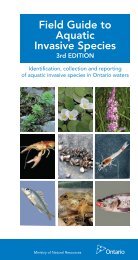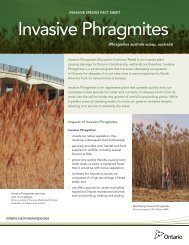Conservation Land Tax Incentive Program - Ministry of Natural ...
Conservation Land Tax Incentive Program - Ministry of Natural ...
Conservation Land Tax Incentive Program - Ministry of Natural ...
You also want an ePaper? Increase the reach of your titles
YUMPU automatically turns print PDFs into web optimized ePapers that Google loves.
<strong>Conservation</strong> <strong>Land</strong> <strong>Tax</strong><strong>Incentive</strong> <strong>Program</strong>Community <strong>Conservation</strong><strong>Land</strong>s Guide<strong>Conservation</strong> <strong>Land</strong> <strong>Tax</strong> <strong>Incentive</strong> <strong>Program</strong>Page 1Community <strong>Conservation</strong> <strong>Land</strong>s Guide February 2010
PurposeThis document has been created to assist conservation groups and conservation authorities indetermining whether or not a property may be eligible under the Community <strong>Conservation</strong><strong>Land</strong>s (CCL) category for the inclusion in the <strong>Conservation</strong> <strong>Land</strong> <strong>Tax</strong> <strong>Incentive</strong> <strong>Program</strong> and toassist in the preparation <strong>of</strong> an application package for that category.The list <strong>of</strong> eligibility criteria provided herein is for information purposes only. The informationcontained in this document is provided as a convenience only and should not be relied on as theauthoritative text. The authoritative text is set out in the <strong>of</strong>ficial consolidated statutes <strong>of</strong>Ontario. The text <strong>of</strong> the Assessment Act and its regulations can be accessed on the E-Lawswebsite at http://www.e-laws.gov.on.ca<strong>Conservation</strong> <strong>Land</strong> <strong>Tax</strong> <strong>Incentive</strong> <strong>Program</strong>Page 1Community <strong>Conservation</strong> <strong>Land</strong>s Guide February 2010
TABLE OF CONTENTS1.0 Introduction ……………………………………………………………………………………….. 31.1 <strong>Program</strong> Overview and Legislative Context ……………………….. 31.1.1 <strong>Program</strong> goal ………………………………………………………………….. 41.1.2 <strong>Program</strong> objectives …………………………………………….. 42.0 Administration ……………………………………………………………………………………….. 52.1 New CCL Applications ………………………………………………………………….. 52.2 Key Dates ……………………………………………………………………………………….. 52.3 Responsibilities and Oversight ……………………………………………………….. 52.4 Notification ……………………………………………………………………………………….. 73.0 Determining CCL Eligibility ………………………………………………………………….. 73.1 Eligible Organization ………………………………………………………………….. 83.2 Eligible <strong>Land</strong> Criteria ..………………………………………………………………… 83.3 Assessing Property Eligibility …………………………………………….. 103.3.1 Eligibility at a Glance …………………………………………….. 103.3.2 Detailed Steps: Assessing Property Eligibility ….. 11CCL Criteria Set Out in O. Reg. 282/98 ……………………….. 11Consistency with the CLTIP Policy ……………………….. 11Property Activities ………………………………………………………………….. 11Compatible Activities …………………………………………….. 12Features or activities that are incompatiblewith the natural heritage and biodiversityobjectives for conserving the land ……………………….. 13Ecological Restoration to Achieve <strong>Natural</strong> Heritageand Biodiversity Objectives …………………………………………….. 13Revenue Generating <strong>Land</strong>s …………………………………………….. 14Farmed <strong>Land</strong>s ………………………………………………………………….. 15Managed Forest <strong>Land</strong>s …………………………………………….. 154.0 Completing the CCL Application …………………………………………….. 164.1 Application Process ………………………………………………………………….. 164.2 Required Documentation ………………………………………………………………….. 164.3 Additional Useful Supplementary Information ……………………….. 18Issue Resolution and Appeals Process …………………………………………….. 18APPENDIX A: Questions and Answers ……………………………………………………….. 19<strong>Conservation</strong> <strong>Land</strong> <strong>Tax</strong> <strong>Incentive</strong> <strong>Program</strong>Page 2Community <strong>Conservation</strong> <strong>Land</strong>s Guide February 2010
2.0 Administration2.1 New CCL ApplicationsFor Community <strong>Conservation</strong> <strong>Land</strong>s, a property not currently recognized under the CLTIP, inpart or in full, can be submitted to the MNR for consideration. A CCL application package, whichcan be obtained by contacting the MNR CLTIP <strong>of</strong>fice, must be submitted by the owner.Unless additional acreage is subsequently requested, the CCL application package is a one-timeonly requirement. Once a property has been approved by the CLTIP, it becomes part <strong>of</strong> thegeneral mailing database and is handled in the same manner as non-CCL properties in theprogram.2.2 Key datesEligible <strong>Tax</strong> Year: The property must be owned by the applicant on January 1 <strong>of</strong> the tax year forwhich the application is submitted (i.e., January 1, 2011 for the 2011 tax year).Applications must be submitted by July 31 <strong>of</strong> the previous year to be eligible for the followingtax year. Reconsiderations for a missed deadline may be applied where the property wasacquired after July 31 but before January 1.The deadline for an MNR Request for Reconsideration is March 31 <strong>of</strong> the tax year disputed. Thedeadline for Appeal to the Assessment Review Board is 90 days from the date <strong>of</strong> Request forReconsideration decision. (Also see section 4.3).Note: as <strong>of</strong> 2009, Requests for Reconsideration are mandatory in order to file an appeal.When program approvals are determined after Municipal Property Assessment Corporationreturns the assessment information to the municipality (usually sometime in December), theMNR will notify and subsequently issue Minutes <strong>of</strong> Settlement to the landowner, which thenmust be signed and returned to the MNR.2.3 Responsibilities and OversightThe <strong>Ministry</strong> <strong>of</strong> <strong>Natural</strong> Resources is the lead <strong>Ministry</strong> for the <strong>Conservation</strong> land <strong>Tax</strong> <strong>Incentive</strong><strong>Program</strong>, however there are a number <strong>of</strong> other organizations, agencies and stakeholders with arange <strong>of</strong> responsibilities under the program<strong>Ministry</strong> <strong>of</strong> <strong>Natural</strong> ResourcesMNR program staff are responsible for providing overall program leadership and direction. TheMNR is also responsible for policy and program development. The MNR ensures applicationsand information about the program are mailed to landowners annually and is responsible forapproval <strong>of</strong> all applications. The MNR provides first stage issue resolution and landownercontact and is party to Mining and <strong>Land</strong>s Commissioner hearings, as referred by the AssessmentReview Board.<strong>Conservation</strong> <strong>Land</strong> <strong>Tax</strong> <strong>Incentive</strong> <strong>Program</strong>Page 5Community <strong>Conservation</strong> <strong>Land</strong>s Guide February 2010
In addition the MNR identifies and maps conservation lands. MNR field staff also identifyprogram/landowner issues and, when appropriate, relay this information to the programadministrator. Questions or issues specific to the resource or its boundary are answered by localdistrict staff.Responsibilities <strong>of</strong> other parties are outlined as follows:Table 1: <strong>Conservation</strong> <strong>Land</strong> <strong>Tax</strong> <strong>Incentive</strong> <strong>Program</strong> - Table <strong>of</strong> Non-MNR ResponsibilitiesMunicipal Property Assessment o Administers province-wide propertyCorporationassessment system based on current valueassessment in accordance with theAssessment Act.o Sends tax notices to landowners<strong>Ministry</strong> <strong>of</strong> Financeo Chief <strong>Ministry</strong> for the Assessment Act andassociated regulationo Assessment Review BoardMining and <strong>Land</strong>s Commissioner o Through a hearing process, resolves issuesregarding classification <strong>of</strong> conservation landson property appeals as referred by theAssessment Review Board.Niagara Escarpment Commission o Responsible for designation <strong>of</strong> Escarpmentnatural Areas within the Niagara EscarpmentPlan jurisdiction.Eligible <strong>Land</strong>owner – Community<strong>Conservation</strong> <strong>Land</strong>sPrivate <strong>Land</strong>ownerMunicipalityo Must identify Community <strong>Conservation</strong><strong>Land</strong>s in accordance with the regulation andsubmit complete application with supportinginformation to the MNRo Must apply annually to remain in the programo Must conform with program policies tomaintain eligibilityo Sign and return received application to theMNR to enter the programo Must return application annually to remain inthe programo Must conform with program policies tomaintain eligibilityo Determines and collects annual property taxesbased on information annually provided byMPAC<strong>Conservation</strong> <strong>Land</strong> <strong>Tax</strong> <strong>Incentive</strong> <strong>Program</strong>Page 6Community <strong>Conservation</strong> <strong>Land</strong>s Guide February 2010
2.4 NotificationCCL applicants can expect to be notified after the review <strong>of</strong> their application <strong>of</strong> either:- Approved as submitted- Approved as amended- Declined applications Incomplete applications (with reasons) Insufficient information Invalid assessment roll number Other reasons as describedNotification is provided immediately upon completion <strong>of</strong> the review <strong>of</strong> the package, either by e-mail or letter mail if e-mail address is not available. If complete application are submitted by thedue date, the landowner will be notified <strong>of</strong> application status (approved/not approved) prior tothe subsequent tax year.3.0 Determining CCL EligibilityCertain conditions <strong>of</strong> eligibility must be met before a parcel <strong>of</strong> land will be consideredconservation land for the purposes <strong>of</strong> inclusion in the CLTIP. These conditions are set out onOntario Regulation 282/98, enacted pursuant to section 3 <strong>of</strong> the Assessment Act, R.S.O. 1990.At a minimum, to be classified as eligible conservation lands, applicants must satisfy thefollowing conditions:1. The parcel <strong>of</strong> land excludes any portion <strong>of</strong> the land that has a building or otherimprovement on it.2. The applicant must be an eligible organization and the land must satisfy the eligibilitycriteria specified under section 25 (3) <strong>of</strong> Ontario Regulation 282/98 (as amended)3. The land is maintained in a manner that contributes to the natural heritage and thebiodiversity objectives for conserving the land.4. The owner submits a completed application to the <strong>Ministry</strong> <strong>of</strong> <strong>Natural</strong> Resources fordesignation <strong>of</strong> the land for the taxation year and the application is submitted inaccordance with the dates set out in O. Reg. 282/985. In the application, the owner undertakes not to engage in activities during the taxationyear that are inconsistent with the natural heritage and biodiversity objectives forconserving the land.6. In the application, the owner undertakes to allow a person selected by the Minister <strong>of</strong><strong>Natural</strong> Resources to inspect the land, and to cooperate with said person7. The Minister <strong>of</strong> <strong>Natural</strong> Resources designates the land as conservation land for thetaxation year; and8. The owner does not breach any undertaking given in the application<strong>Conservation</strong> <strong>Land</strong> <strong>Tax</strong> <strong>Incentive</strong> <strong>Program</strong>Page 7Community <strong>Conservation</strong> <strong>Land</strong>s Guide February 2010
3.1 Eligible OrganizationAs specified under Ontario Regulation 282/98 <strong>of</strong> the Assessment Act, 1990, an organization iseligible if(a) it is a registered charity, within the meaning <strong>of</strong> subsection 248(1) <strong>of</strong> the Income <strong>Tax</strong> Act(Canada) and its primary objectives are related to natural heritage conservation, or(b) it is a conservation authority under the <strong>Conservation</strong> Authorities Act, 1990Charitable organizations applying for the first time must supply a copy <strong>of</strong> the Letters Patent andobjects <strong>of</strong> the corporation.3.2 Eligible <strong>Land</strong> CriteriaAs specified under Section 25 (3) <strong>of</strong> Ontario Regulation 282/98 <strong>of</strong> the Assessment Act, 1990,land is eligible if it satisfies one <strong>of</strong> the following conditions:1. The land is designated as an escarpment protection area in the Niagara Escarpment Planunder the Niagara Escarpment Planning and Development Act (1990).2. The land is located within a Featured Area and contributes to the natural heritageprotection objectives established for the Featured Area as set out in the “Ontario LivingLegacy <strong>Land</strong> Use Strategy, July 1999”, published by the Queen’s Printer.3. The land is a natural heritage feature or area that meets the criteria <strong>of</strong> the naturalheritage provisions <strong>of</strong> the Provincial Policy Statement as issued and re-issued undersection 3 <strong>of</strong> the Planning Act (1990).4. The land is identified by the Minister <strong>of</strong> <strong>Natural</strong> Resources as a regionally significant area<strong>of</strong> natural and scientific interest using the criteria set out in the <strong>Ministry</strong> <strong>of</strong> <strong>Natural</strong>Resources document entitled “A Framework for the <strong>Conservation</strong> <strong>of</strong> Ontario’s BiologicalHeritage”, dated May, 1980, or in the <strong>Ministry</strong> <strong>of</strong> <strong>Natural</strong> Resources document entitled “AFramework for the <strong>Conservation</strong> <strong>of</strong> Ontario’s Earth Science Features”, dated October,1981.5. It is habitat <strong>of</strong> a species that is listed as a special concern species in Schedule 4 toOntario Regulation 230/08 (Species at Risk in Ontario List) made under the EndangeredSpecies Act 2007.6. The land is identified as having species occurrences or ecological communities with an S-Rank designation <strong>of</strong> S1-S3, as determined by the <strong>Natural</strong> Heritage Information Centre <strong>of</strong>the <strong>Ministry</strong> <strong>of</strong> <strong>Natural</strong> Resources.7. The land is designated as a natural core area, natural linkage area or countryside in theOak Ridges Moraine <strong>Conservation</strong> Plan under the Oak Ridges Moraine <strong>Conservation</strong> Act,2001.8. The land is a natural heritage area identified within a regional or watershed plan orstrategy developed by a conservation authority under the <strong>Conservation</strong> Authorities Act(1990) or by another public agency under another provincial or federal statute.9. The land is designated as an environmentally sensitive area, environmentally significantarea, environmental protection area, natural heritage system or another area with anequivalent designation within a municipal <strong>of</strong>ficial plan or zoning by-law under thePlanning Act (1990).<strong>Conservation</strong> <strong>Land</strong> <strong>Tax</strong> <strong>Incentive</strong> <strong>Program</strong>Page 8Community <strong>Conservation</strong> <strong>Land</strong>s Guide February 2010
10. (a) The land is within, abuts or abuts a road allowance that abuts a provincial park,national park, conservation reserve or provincial wildlife area and contributes significantlyto the natural heritage objectives <strong>of</strong> the park, reserve or wildlife area.(b) Despite paragraph 10 (a), no part <strong>of</strong> the land that is more than 1,000 metres fromthe boundary <strong>of</strong> the park, reserve or wildlife area is eligible to be classified as eligibleconservation land.11. The land is an area identified under the Great Lakes Wetlands <strong>Conservation</strong> Action Plandescribed in the “Great Lakes Wetlands <strong>Conservation</strong> Action Plan Highlights Report(2000-2003)”, published by Environment Canada.<strong>Land</strong> that is eligible under criteria specified in Section 25 (2) <strong>of</strong> O. Reg. 282/98 i.e. the fourregular CLTIP categories as described below, should not be submitted for CCL consideration.Those lands, if not currently identified as eligible, should be brought forward to CLTIPadministrator for inclusion under those designations.Ontario Regulation 282/98 Section 25 (2) reads:1. The land is identified by the Minister <strong>of</strong> <strong>Natural</strong> Resources as provincially significant wetlandon the basis <strong>of</strong> the wetland evaluation system set out in the <strong>Ministry</strong> <strong>of</strong> <strong>Natural</strong>Resources document entitled “Ontario Wetland Evaluation System Southern Manual”(3rd edition), dated March, 1993, as revised in May, 1994 and December, 2002, or inthe <strong>Ministry</strong> <strong>of</strong> <strong>Natural</strong> Resources document titled “Ontario Wetland Evaluation SystemNorthern Manual” (1st edition), dated March, 1993, as revised in May, 1994 andDecember, 2002.2. The land is identified by the Minister <strong>of</strong> <strong>Natural</strong> Resources as a provincially significant area <strong>of</strong>natural and scientific interest using the criteria set out in the <strong>Ministry</strong> <strong>of</strong> <strong>Natural</strong>Resources document entitled “A Framework for the <strong>Conservation</strong> <strong>of</strong> Ontario’s BiologicalHeritage”, dated May, 1980, or in the <strong>Ministry</strong> <strong>of</strong> <strong>Natural</strong> Resources document titled “AFramework for the <strong>Conservation</strong> <strong>of</strong> Ontario’s Earth Science Features”, dated October,1981.3. The land is identified by the Minister <strong>of</strong> <strong>Natural</strong> Resources as habitat <strong>of</strong> a species that islisted as an endangered species in Schedule 2 to Ontario Regulation 230/08 (Species atRisk in Ontario List) made under the Endangered Species Act 2007, using the criteria setout in the <strong>Ministry</strong> <strong>of</strong> <strong>Natural</strong> Resources document entitled “Guidelines for MappingEndangered Species Habitats under the <strong>Conservation</strong> <strong>Land</strong> <strong>Tax</strong> <strong>Incentive</strong> <strong>Program</strong>”, as itmay be amended from time to time and set out in a Decision Notice posted on theenvironmental registry under the Environmental Bill <strong>of</strong> Rights, 1993.4. The land is designated as an escarpment natural area in the Niagara Escarpment Plan underthe Niagara Escarpment Planning and Development Act. O. Reg. 388/04, s. 1; O. Reg.389/08, s. 1.<strong>Conservation</strong> <strong>Land</strong> <strong>Tax</strong> <strong>Incentive</strong> <strong>Program</strong>Page 9Community <strong>Conservation</strong> <strong>Land</strong>s Guide February 2010
3.3 Assessing Property EligibilityIn determining the eligibility <strong>of</strong> a property for the Community <strong>Conservation</strong> <strong>Land</strong>s category, theapplicant needs to first ask several preliminary questions as outlined below. If the applicant cananswer “yes” to those questions, and provide the accompanying information to support thoseclaims, then the property is a likely candidate for consideration under the CLTIP CCL category.These questions can be used as steps to assess suitability for a property under the CCLcategory.3.3.1 Eligibility at a GlanceThe following flow chart identifies three key questions that should be asked in assessingpotential CCL eligibility <strong>of</strong> a property. For a more complete determination see Detailed Steps:Assessing Property EligibilityChart 1: CCL Eligibility at a GlanceDoes the property, or a portionthere<strong>of</strong>, fall under one <strong>of</strong> the subcriteriaset out in Section 25.(3) <strong>of</strong>O.Reg. 282/98?YesIs the property, or portionthere<strong>of</strong>, that qualifies underSection 25.(3) being used ormaintained in a mannerconsistent with CLTIP policydirection, as outlined in policy #?YesNoNoNoProperty is NotEligible Under CLTIPCan documentation be provided insupport <strong>of</strong> the application for CCLdesignation?YesThe property appears to be agood candidate for the CLTIP CCLcategory, subject to MNRapprovalSupporting documentation mustbe included. Applications cannotbe considered without it. Theonus is on the applicant toprovide copies <strong>of</strong> thedocumentation, unless otherarrangements with the CLTIPadministrator have been made.<strong>Conservation</strong> <strong>Land</strong> <strong>Tax</strong> <strong>Incentive</strong> <strong>Program</strong>Page 10Community <strong>Conservation</strong> <strong>Land</strong>s Guide February 2010
3.3.2 Detailed Steps: Assessing Property EligibilityCCL Criteria Set Out in O. Reg. 282/98There are 11 types <strong>of</strong> eligible land classifications under the Community <strong>Conservation</strong> <strong>Land</strong>scategory as listed in Section 3.2 above. For several <strong>of</strong> the 11 CCL eligible land classifications,there are a number <strong>of</strong> sub-types or designations included, <strong>of</strong>ten quite distinct from one another.The applicant may be required to provide the supporting information, demonstrating that aparcel <strong>of</strong> land satisfies one <strong>of</strong> the criteria. For example, under the criterion, “natural heritagefeature or area that meets the criteria <strong>of</strong> the natural heritage provisions <strong>of</strong> the Provincial PolicyStatement”, land can qualify as adjacent land to a provincially significant wetland or assignificant woodland or valleyland. The agencies responsible for designating those lands willvary, i.e., MNR designates provincially significant wetlands but municipalities designatesignificant woodlands and valleylands. Consequently, the supporting information and rationalewill also differ. The onus is on the applicant to provide all background and supportinginformation as outlined in Section 4.Consistency with the CLTIP PolicyThe CLTIP policy identifies program objectives and establishes a framework to evaluate whichlands, land uses and activities are permitted under the program and identifies how propertiescan contribute to the natural heritage and biodiversity objectives for conserving the land. Thepolicy also identifies activities and land uses that, for the purposes <strong>of</strong> this program, areinconsistent with the natural heritage and biodiversity objectives for conserving the land.The goal <strong>of</strong> the CLTIP is to recognize, encourage and support the long-term stewardship <strong>of</strong>specific categories <strong>of</strong> conservation land by <strong>of</strong>fering tax exemption to those landowners whoagree to protect the natural heritage values <strong>of</strong> their property.For CCL it must be demonstrated that direction, objectives or a plan is in place that clearlydescribes the natural heritage and biodiversity objectives for the property and how thoseobjectives will be achieved. If property specific objectives or plans exist these too should besubmitted with the application. Failure to do so could result in a rejected application should thebalance <strong>of</strong> the information be insufficient.The MNR would encourage the development <strong>of</strong> formal resource plans for Community<strong>Conservation</strong> <strong>Land</strong>s under the program. Should the property have multiple designations, i.e.MFTIP, a comprehensive plan would be desirable.Property ActivitiesThe CLTIP was established to encourage landowners to protect the natural heritage values <strong>of</strong>their property and the Community <strong>Conservation</strong> <strong>Land</strong> category was created to provide similarincentives for conservation organizations, which have an established mandate <strong>of</strong> naturalheritage and biodiversity protection and conservation authorities. Activities that have a negativeimpact on the natural heritage components <strong>of</strong> the lands cannot be undertaken. <strong>Land</strong>ownersunder the CLTIP are not required to produce an area specific management plan <strong>of</strong> proposedactivities. However landowners are encouraged to develop resource management plans 1 for thelands they own.1 You may wish to consult the ‘Guide to Stewardship Planning for <strong>Natural</strong> Areas’ for ideas. http://www.mnr.gov.on.ca/MNR_E000231.pdf<strong>Conservation</strong> <strong>Land</strong> <strong>Tax</strong> <strong>Incentive</strong> <strong>Program</strong>Page 11Community <strong>Conservation</strong> <strong>Land</strong>s Guide February 2010
Compatible Activities<strong>Land</strong>owners are encouraged to enjoy their natural heritage lands and activities that haveminimal impact on the soils and vegetation or landscape are encouraged.Low impact recreational activities where there is little or no impact on the natural heritage /biodiversity features and objectives are permitted (subject to other legislative requirements oradditional limitations imposed by the landowner).This includes but is not limited to, activities such as: hiking, cross-country skiing, snowshoeing,hunting, fishing, and wildlife viewing.The following is a list (non-exhaustive) <strong>of</strong> management activities which are permitted onproperties eligible under CLTIP (subject to other legislative requirements or additionallimitations imposed by the landowner) with prior landowner notification to MNR CLTIP staffregarding the undertaking <strong>of</strong> the management activity.Invasive species managementInfill planting <strong>of</strong> native species representative <strong>of</strong> the ecosystemPrescribed burnsPlanned trail maintenanceTree felling/removal for health (i.e. infested or infected trees) or safety purposes, wherethe wood is not soldThe following is a list <strong>of</strong> management activities which may be permitted on properties eligibleunder CLTIP pending MNR approval which may require additional information, and possiblyinclude conditions for approval. Failure to obtain MNR approval may result in future exclusion <strong>of</strong>the landowner from the program.Culling non-native tree species (where non-native species are a minor component <strong>of</strong> theforest and culling would enhance residual natural heritage values) (Note: Areasdominated by non-native species are not normally eligible under CLTIP)Tree removal/felling for health (i.e. infested or infected trees) or safety purposes, whenthe wood is intended to be soldFuelwood removal, for sustainable personal use onlyPlanned trail development or upgrading – with no demonstrated negative impacts onnatural heritage or biodiversity values as evaluated and reported during traildevelopment planningThe activities which are consistent with conservation use are dependent upon the nature <strong>of</strong>features to be protected. If a land use activity occurs that detrimentally affects the featureswhich initially resulted in an area being identified as conservation land, that land may no longerbe eligible for tax exemption under the program.MNR will make the final decision with respect to program compatibility. When the determination<strong>of</strong> compatibility based on policy may not be clear, MNR will make the decision based uponwhether the program objectives are being achieved, whether the land should be included under<strong>Conservation</strong> <strong>Land</strong> <strong>Tax</strong> <strong>Incentive</strong> <strong>Program</strong>Page 12Community <strong>Conservation</strong> <strong>Land</strong>s Guide February 2010
another more appropriate program and whether the feature(s) for which the land has beenincluded in the program are being negatively impacted.Features or activities that are incompatible with the natural heritage andbiodiversity objectives for conserving the landThe following is a list <strong>of</strong> land features or activities that, for the purposes <strong>of</strong> this program, areconsidered to be inconsistent with the natural heritage and biodiversity objectives forconserving the land. Note that this is not an exhaustive list. Other conditions <strong>of</strong> a similar natureto those listed below may not be accepted. Ineligibility applies to the portion <strong>of</strong> the land withthese ineligible features and not to the remainder <strong>of</strong> the property that otherwise meets theeligibility criteria, for which eligibility has been proposed. Built Areas: Buildings or improvements and the lands associated with them (includesmaintained roadways and parking facilities) <strong>Land</strong>scaped Areas: <strong>Land</strong>scaped and groomed areas (e.g., recreation areas, such aspicnic-camping-swimming areas, ski hills) Farmed Areas: Includes areas recently or currently part <strong>of</strong> a farming operation(including crop farming, fallow field rotation and pasture lands). Also includes recentlyabandoned farmed lands where the vegetative cover is not representative <strong>of</strong> the naturalecosystem. Site Alteration: Includes, but not limited to; draining, dredging, filling <strong>of</strong> wetlands;aggregate extraction; grading and soil removal. Commercial Timber Harvesting: Harvesting <strong>of</strong> merchantable wood with the intent oroutcome <strong>of</strong> the sale, barter or trade <strong>of</strong> forest products (Properties that have beencommercially harvested are not eligible to participate in CLTIP for a period <strong>of</strong> at leastten years after the harvest has taken place.)Harvesting <strong>of</strong> non-timber forest products for sale, barter or tradeUnrepresentative Conditions: Areas dominated by non-native or invasive vegetativespecies; Plantations which include non-native species that have been planted, managedfor the production <strong>of</strong> fruits, nuts, Christmas trees or nursery stock or that are managedfor forest products.<strong>Land</strong>s that are intended to be restored or are restored with inappropriate species, asevaluated by the MNR, will not normally be included. Once restoration activities havebeen completed these lands may be included (provided that it has been at least 10years since the land was commercially harvested).Motorized vehicle use: Off-trail use is generally prohibited except for infrequent <strong>of</strong>f trailuse, where values are not negatively impactedExceptions may be considered by the program administrator where the land is specificallydesignated for habitat maintenance or recovery (e.g. ongoing grazing for the provision <strong>of</strong>Loggerhead Shrike habitat.) or where surficial land use does not affect the feature (e.g. EarthScience ANSI).Ecological Restoration to Achieve <strong>Natural</strong> Heritage and Biodiversity Objectives<strong>Conservation</strong> organizations play an important role in restoring conservation lands to provide arobust natural heritage system that supports biodiversity in Ontario; this includes lands that aregoing through various stages <strong>of</strong> succession. It is recognized that many natural areas particularlyin southern Ontario are degraded to varying degrees. In some circumstances ecological<strong>Conservation</strong> <strong>Land</strong> <strong>Tax</strong> <strong>Incentive</strong> <strong>Program</strong>Page 13Community <strong>Conservation</strong> <strong>Land</strong>s Guide February 2010
estoration may be an acceptable land use management activity. <strong>Land</strong>s may be consideredeligible where the activities being undertaken contribute to the natural heritage and biodiversityobjectives for conserving the land.<strong>Land</strong>s that are intended to be restored or are restored with inappropriate species, as evaluatedby the MNR, will not normally be included. With regard to restoration lands, once restorationactivities have been completed these lands may be included (provided that it has been at least10 years since the land was commercially harvested). The determination <strong>of</strong> ‘completion’ meansthat additional restoration activities (i.e. planting, seeding) are not required for development <strong>of</strong>a representative condition to proceed through natural succession. In most circumstances thiswill likely be determined by the completion <strong>of</strong> planting. If planting is scheduled over multipleconsecutive years then the property is eligible after planting has been completed. In the eventthere are multiple ‘phases’ <strong>of</strong> planting to achieve a specific forest condition, the property couldbe eligible after the completion <strong>of</strong> the first phase <strong>of</strong> planting, on the area planted.For CCL it must be demonstrated that direction, objectives or a plan is in place that clearlydescribes the natural heritage conservation objectives for the land and how those objectives willbe achieved. If property specific restoration objectives or plans exist these too should besubmitted with the application.The MNR would encourage the development <strong>of</strong> formal restoration management plans forCommunity <strong>Conservation</strong> <strong>Land</strong>s under the program that are being restored.Revenue Generating <strong>Land</strong>sThe CLTIP is an incentive program designed to encourage the conservation and protection <strong>of</strong>significant conservation lands in Ontario. It is understood that private lands are owned andused for a wide variety <strong>of</strong> purposes and by a diverse array <strong>of</strong> individuals.As the tax exemption provided is intended as an incentive, not as compensation or net revenueenhancement, revenue producing lands are not normally eligible under the CLTIP. Forest landsthat are otherwise eligible under the CLTIP, but are actively managed to provide revenue andforest products, in addition to contributing to natural heritage values, are more appropriatelyincluded under the Managed Forest <strong>Tax</strong> <strong>Incentive</strong> <strong>Program</strong> e.g. selective thinning <strong>of</strong> pineplantations.Selling forest or non-timber forest products that would result in the removal <strong>of</strong> natural featuresand/or biodiversity, would not normally be permitted. Limited sale <strong>of</strong> forest products as a result<strong>of</strong> special circumstances (e.g. sale <strong>of</strong> trees removed for safety or health purposes) may bepermitted with the approval <strong>of</strong> the MNR.For eligible conservation lands where a fee is charged by the eligible landowner to enter ontolands or partake in compatible activities that fee would be considered incidental and the landwould not be excluded from the program as a result.<strong>Conservation</strong> <strong>Land</strong> <strong>Tax</strong> <strong>Incentive</strong> <strong>Program</strong>Page 14Community <strong>Conservation</strong> <strong>Land</strong>s Guide February 2010
Farmed <strong>Land</strong>sFor the purposes <strong>of</strong> this program, farmed lands are inconsistent with the natural heritage andbiodiversity objectives for the conservation lands and are not eligible. For earth science Areas <strong>of</strong><strong>Natural</strong> and Scientific Interest, because it is the geology that is important, as long as thefarming activity does not affect the soils and substrates, the activity is generally permitted. Forcertain endangered species habitat, some farming activities may be acceptable (e.g. pasturing<strong>of</strong> cattle on loggerhead shrike habitat would be permitted as it is a recognized activity tomaintain suitable foraging habitat for the species).Managed Forest <strong>Land</strong>sThe Managed Forest <strong>Tax</strong> <strong>Incentive</strong> <strong>Program</strong> (MFTIP) is a voluntary program <strong>of</strong>fered by theMNR. This program is available to landowners who own four hectares or more <strong>of</strong> forested land,and who agree to prepare and follow a Managed Forest Plan for their property. Under theMFTIP, eligible lands are reassessed and assigned to a Managed Forest property classificationand taxed at 25 percent <strong>of</strong> the municipal tax rate set for residential properties.The MFTIP has been designed to increase landowner awareness about forest stewardship,enable landowners to re-invest in their forested properties, and minimize the long-term decline<strong>of</strong> forest cover, particularly in southern Ontario. The MFTIP is an essential component <strong>of</strong>Ontario’s “greening initiatives” and the long-term stewardship <strong>of</strong> forested landscapes andnatural heritage on private lands in Ontario. This program encourages private landowners topractice responsible stewardship while contributing to Ontario’s healthy natural environment.<strong>Land</strong>owners participating in MFTIP have a range <strong>of</strong> stewardship objectives includingenvironmental protection, nature appreciation, recreation, wildlife habitat as well as theproduction <strong>of</strong> forest products.While many <strong>of</strong> the objectives <strong>of</strong> MFTIP are complementary to CLTIP, there are somemanagement and land use activities that are considered to be inconsistent with the goal <strong>of</strong>CLTIP. This may include but is not limited to forest management activities associated withwood production objectives. These properties are not eligible under the CLTIP.Forested properties which do not meet the specific criteria set forth in O. Reg. 282/98 andCLTIP policies, are not eligible under the CLTIP, but may be eligible under MFTIP. To avoidinappropriately moving from one incentive program to another and to ensure natural heritagefeatures have begun to recover, properties that have been commercially harvested are noteligible to participate in CLTIP for a period <strong>of</strong> at least ten years after the harvest has takenplace. Exceptions may be made by the MNR in specific circumstances.Management activities associated with maintaining forest health (e.g., the removal <strong>of</strong> diseasedtrees, invasive species control) or safety (e.g., the removal <strong>of</strong> broken branches or trees acrosswalking trails) are permitted under the CLTIP, with program notification prior to activities takingplace.Properties that are not currently in MFTIP and do not meet the above criteria are not eligible forCLTIP. If the forested area <strong>of</strong> the property is greater than 9.88 acres, the landowner may<strong>Conservation</strong> <strong>Land</strong> <strong>Tax</strong> <strong>Incentive</strong> <strong>Program</strong>Page 15Community <strong>Conservation</strong> <strong>Land</strong>s Guide February 2010
consider MFTIP. This program has its own set <strong>of</strong> eligibility criteria. Additional details can befound on the MNR website http://www.mnr.gov.on.ca/en/<strong>Program</strong>s/index.html4.0 Completing the CCL Application4.1 Application ProcessThe CLTIP is currently an annual program. You must apply every year to continue participationin the program. The CCL application packages are required for first-time application <strong>of</strong> a newproperty only.Once approved, properties are treated in the same manner as other properties under theprogram (i.e., returned signed application only) in subsequent years.4.2 Required DocumentationThe following information as described in the CCL application package, is required.Applicant Information:Full name <strong>of</strong> organization and current mailing address;Contact Name, phone number, e-mail address.Property Information: valid and current Assessment Roll Number, legal description, total acres(must be precise) and conservation land acres applied for.For charitable conservation organizations: pro<strong>of</strong> <strong>of</strong> charitable organization status under theIncome <strong>Tax</strong> Act and copy <strong>of</strong> letters patent and objectsInformation is required to readily demonstrate and support the criterion under which theapplication is being submitted, including sub-designations where one or more exist. Applicantswill be notified <strong>of</strong> incomplete applications (with reasons) and these will not be reviewed. Theonus is on the applicant to ensure that all necessary information is provided.All information, including the correct assessment roll number, is required at time <strong>of</strong> submission.Do not submit partially complete application packages. These will not be retained by the<strong>Program</strong>.The following information is mandatory: Application completed in full – includes correct assessment roll number, relevantsubcategory <strong>of</strong> eligible type, date <strong>of</strong> acquisition and appropriate attachments and/orsupporting documentation <strong>Natural</strong> areas site description – detailed description <strong>of</strong> proposed eligible land, andrelevance to application if applicable (e.g., description <strong>of</strong> species habitat and ecologicalcommunities; contribution to management plan objectives) Locator map for property – must be at a scale where property can be located on thelarger landscape Detailed property map – shows location and extent <strong>of</strong> proposed conservation landAND location <strong>of</strong> any other property classifications (e.g., Managed Forest, Residential,Farmland) and buildings or structures Supporting documentation that establishes eligibility under criterion. For eachsubtype, this includes, but is not limited to:<strong>Conservation</strong> <strong>Land</strong> <strong>Tax</strong> <strong>Incentive</strong> <strong>Program</strong>Page 16Community <strong>Conservation</strong> <strong>Land</strong>s Guide February 2010
o Niagara Escarpment protection area – map showing <strong>of</strong>ficial NEC planning areadesignation(s) with property boundary (copy <strong>of</strong> NEC plan is not required)o Ontario Living Legacy (OLL) Featured Area – map showing location <strong>of</strong> property incontext <strong>of</strong> identified Featured Area and portion <strong>of</strong> property that is eligible; FeaturedArea descriptiono <strong>Natural</strong> heritage feature or area as established by the PPS – identification <strong>of</strong> the PPSfeature on the property; written confirmation from designating authority whenauthority is not MNRo Regionally significant ANSI – identification <strong>of</strong> ANSI and mapping to show locationand extent on propertyo Habitat <strong>of</strong> species <strong>of</strong> special concern – identification <strong>of</strong> species and mapping showinglocation and extent <strong>of</strong> contiguous habitat; supporting documentation e.g. club oragency natural heritage inventory with confirmation by a reputable specialist orconsultanto Species occurrence or ecological community with s-rank 1-3 as determined by the<strong>Natural</strong> Heritage Information Centre (NHIC) – identification <strong>of</strong> species/ communityand S-Rank; supporting documentation e.g. club or agency natural heritageinventory with confirmation by a reputable specialist or consultanto <strong>Natural</strong> core, natural linkage or countryside in Oak Ridges Moraine Plan (ORM) –identification <strong>of</strong> ORM designation; map showing location and extent <strong>of</strong> designatedoarea on property<strong>Natural</strong> heritage area identified within a regional or watershed plan or strategydeveloped by a conservation authority or a public agency under another provincial orfederal statute – copy <strong>of</strong> approved plan or strategy with relevant text clearlymarked; copy <strong>of</strong> plan or strategy mapping showing property location; property mapshowing location and extent <strong>of</strong> designated area on propertyo Designated environmentally sensitive area, environmentally significant area,environmental protection area, natural heritage system or other designation within amunicipal <strong>of</strong>ficial plan (OP) or zoning bylaw – excerpt from municipal plan describingdefinition, purpose and uses <strong>of</strong> designation, with relevant text highlighted; coverpage, table <strong>of</strong> contents and foreword or executive summary <strong>of</strong> OP with effectivedate clearly marked; OP or zoning bylaw maps at a scale that clearly establisheseligibility on property (bylaw maps are required where sub-designations are used,e.g., OS1, OS2)ooWithin or abuts a “protected area” and contributes significantly to the naturalheritage objectives <strong>of</strong> the park, reserve or wildlife area – copy <strong>of</strong> “protected area”management plan or documentation that describes its mandate and objectives, withrelevant information highlighted; documentation that shows how the propertycontributes to the protected area natural heritage objectives; map <strong>of</strong> <strong>of</strong>ficial parkboundary and location <strong>of</strong> property (Note: only the area within 1 km <strong>of</strong> the protectedarea is eligible and the area must be adjacent to the boundary or separated only bya road allowance)Identified under the Great Lakes Wetlands <strong>Conservation</strong> Action Plan HighlightsReport (2000-2003) – reference to relevant section <strong>of</strong> GLWCAP under which eligiblewetland falls<strong>Conservation</strong> <strong>Land</strong> <strong>Tax</strong> <strong>Incentive</strong> <strong>Program</strong>Page 17Community <strong>Conservation</strong> <strong>Land</strong>s Guide February 2010
All relevant information must be highlighted. This can include references to relevantinformation, e.g., “see page 13 <strong>of</strong> Official Plan, <strong>Natural</strong> Heritage System.”Maps must be property and completely labelled, including relevant legends and sources <strong>of</strong>information. Colour-plate originals must be reproduced in colour. Where more convenient,electronic documents may be submitted (e.g., PDF); they must be at a high quality resolutionand clearly and relevantly named.The eligible landowner has the responsibility to provide sufficient information in their programapplication for the MNR to make the determination <strong>of</strong> program eligibility in a timely manner.The submission <strong>of</strong> applications with incomplete, insufficient or incorrect information may resultin the rejection <strong>of</strong> the application. There is no requirement or obligation for MNR to contact thelandowner before rejection an application that is incomplete, insufficient or incorrect. Theprogram administrator may contact landowners who have submitted incomplete, insufficient orincorrect applications at their discretion.4.3 Additional Useful supplementary information: For properties currently or previously under MFTIP, a copy <strong>of</strong> the managed forest plan,including managed forest area objectives, 10-year activity summary and the report <strong>of</strong>activities Current satellite imagery Photographs, especially a series over time Forest resources inventory mapping where available and relevant Documentation regarding direction or objectives or a plan that clearly describes thenatural heritage conservation objectives and how they will be achieved.Issue Resolution and Appeals ProcessCCL eligibility is determined based on information provided at the time <strong>of</strong> submission <strong>of</strong> theapplication. Where landowners do not agree with the decision to include or exclude lands,requested for reconsideration or appeals may be filed through the appeal process as describedin Sections 38 and 39 <strong>of</strong> O. Reg. 282/98 (Requests for Reconsideration are under Section 39.1and Appeals under Section 40 <strong>of</strong> the Assessment Act.)Where an application has been declined or amended due to an incomplete application package,insufficient information, errors to the assessment roll number or other matters <strong>of</strong> opinion, asdetermined by the CLTIP administrator, supplementary information may be submitted but theapplication will only be reconsidered for the following tax year.Factual errors in information, brought forward through a Request for Reconsideration, may beadjusted for the original application year, contingent on MPAC still accepting changes.<strong>Conservation</strong> <strong>Land</strong> <strong>Tax</strong> <strong>Incentive</strong> <strong>Program</strong>Page 18Community <strong>Conservation</strong> <strong>Land</strong>s Guide February 2010
Appendix A: Questions & AnswersQ: What are common problems that result in an application being declined?A: Common problems that result in an application being declined include: invalid roll number – either an obsolete roll number or a property severance oramalgamation has occurred, with a roll number change discrepancy in parcel mapping – parcel mapping supplied does not concur withTeranet digital parcel layer lack <strong>of</strong> natural areas site description lack <strong>of</strong> supporting documentation – plans, MF plan components (especiallycompartment mapping/ descriptions/ objectives/ activities) inadequate or inappropriate mapping (scale, detail or legend) property already 100% eligible & participating entire property submitted when building/ structures obviousQ: If my property is already 100% eligible and participating under theCLTIP, and I am an eligible conservation organization, do I need to resubmitthe property under this category to maintain its eligibility?A: No. If the property is already fully eligible under one <strong>of</strong> the 4 regular CLTIPcategories, then you are not required to submit it under this category. The CCLcategory only applies to lands outside <strong>of</strong> the normally designated eligible lands (seeAppendix A, Section 25(2)). It should only be submitted if there are additional areas forconsideration.Q. What does a natural areas site description entail?A: A natural areas site description is an account <strong>of</strong> the features and/or elements on theproperty. It provides information regarding the physical and biological components <strong>of</strong>the property. For example, a natural areas site description might include a summary <strong>of</strong>the vegetation communities found on the property and a description <strong>of</strong> the physicallandscape. A natural areas site description should also provide an explanation <strong>of</strong> theimportance and/or function <strong>of</strong> the property in a greater landscape context forproperties, especially for those that are small in size or fragments <strong>of</strong> larger areas.Q. How do I get an application?A: Application forms can be obtained by contacting the CLTIP <strong>of</strong>fice, <strong>Ministry</strong> <strong>of</strong> <strong>Natural</strong>Resources, Peterborough.<strong>Conservation</strong> <strong>Land</strong> <strong>Tax</strong> <strong>Incentive</strong> <strong>Program</strong>Page 19Community <strong>Conservation</strong> <strong>Land</strong>s Guide February 2010


